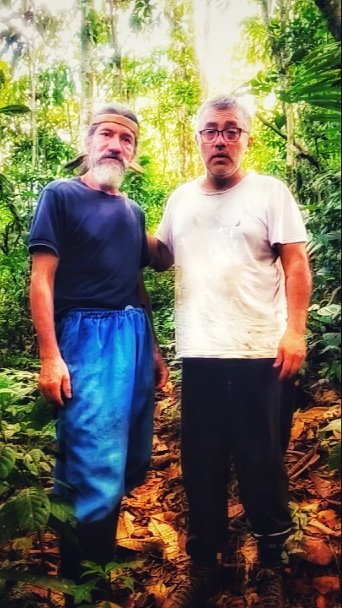Why smallfarmers matter in the carbon market
Subsistence farmers in tropical forests are the planet’s climate swing-vote
Smallfarmers, also known as subsistence farmers, are the most under-utilized global element in the fight against climate change. It’s ethnocentric to view conservation as an industrialized-world pursuit when indigenous peoples have a 5,000-year-long success record. We think a smallfarmer can be you, and your planet’s best friend. Here’s why...
Ramon & Silvio, Savimbo growers in the Colombian Amazon
“What we are doing to the forests of the world is but a mirror reflection of what we are doing to ourselves and to one another”
More than 1 billion people live in tropical forests. Humans leave a distinctive mark on Earth every day. Unfortunately, this stamp isn’t particularly positive. An estimated 420 million hectares of forest have been deforested globally since 1990. And despite our lip service, environmental degradation continues advancing at a steady pace. The United Nations estimated in 2020 that 10 million hectares continue to be deforested annually, predominantly because of unsustainable agriculture. Deforestation in South America is one of the world's biggest problems today.
Understanding what economic activities contribute to deforestation, along with the subsistence economies definition, is necessary to comprehend this population's needs. We need to stop criticizing and listen before we can offer them clear economic incentives to conserve and reforest. At Savimbo, we think this is the biggest step forward the carbon market could take in the next 20 years.
Deforestation isn't complicated, but changing it requires unique solutions and open-minded curiosity. Rather than parroting judgments, we have to really ask ourselves what we really know about it. What do subsistence farmers do? How are intensive smallholder crops and livestock unique? How does farming in the forest hurt biodiversity? And how does deforestation disrupt the carbon cycle?
Perhaps more importantly, there are economic advantages to subsistence farming and small-scale agriculture. So how do we create a sustainable small farm?
Smallfarmers, an eco-army to fight the climate crisis
“Trees exhale for us to inhale them and stay alive. Can we ever forget that? Let’s love trees until our last breath.”
It would be a mistake to believe that smallfarmers do not love their forests. Industrialized nations often ethnocentrically assume that deforestation in tropical forests manifests ignorance, instead of poverty. The modern world already presents plenty of challenges to subsistence farmers. We must consider, as industrialized nations examine our own decimated wildlands and lost wildlife, that we now demand the world’s poorest peoples to win a battle we ourselves have lost.
But they are still winning. Currently, a staggering 80% of the world's biodiversity is protected by indigenous societies, and as the Smithsonian describes, they have held this land, extracting meaningful use with little ecological damage, for nearly 5,000 years.
Since we do not know how we ourselves would respond to the pressures these people face, we must instead ask them. What are their choices? And given alternative options what would they do differently? As Soikan, a Maasai pastoralist who works with indigenous communities in Kenya to reduce deforestation told World Bank interviewers “I saw education as the way I could elevate my community”. Perhaps what smallholding communities really need is meaningful trade.
The fact is, 1 billion autonomous people with a history of conservation, strong ties to indigenous communities, finely honed work ethic, and remarkably low living wage inhabit the borderlands of our most threatened tropical forests. There's no doubt that they can bring positive environmental impacts.
Why aren’t we trying harder to buy environmental products from them?
What is subsistence farming and why do we care?
“Among the branches of the great trees I have climbed to look at the sky… with its fruit I have been satisfied; with their wood, heated: to them I owe my life…”
It would be unwise to believe that only our massive corporations impact the environment. The reality is that every human on this planet impacts its sustainability, and shares the need to change its meaningful use.
What are subsistence farmers? Subsistence farmers are also called smallfarmers, a population technically defined as people who plant for the sole purpose of feeding their family. The World Wildlife organization contextualizes the importance of farmers as a group: “Farming is the only viable livelihood option for three-quarters of the global population living below the poverty line”. This often-ignored population is digitally silent, lives in areas of the world poorly served by central governments, and relies on their wits, pragmatism, and their own labor to survive. We can't deny the environmental impact of subsistence farming. In fact, we ignore them at our peril and our planet's peril. But how do we work with them?
First, we need to understand subsistence farming characteristics — where is subsistence agriculture most common? We find most of the survival farming happens in families living on the edge of the tropical forest or in its mosaic lands. These local communities are living and working inside critical biozones, which makes them the swing voters of the forests we seek to conserve. In the World Bank’s words: “Indigenous Peoples and local communities have the closest connection with forests, and with the right knowledge and tools, they are best placed to manage them sustainably”.
Intensive smallholder crops and livestock are financially unique. There are clear economic differences between subsistence and commercial agriculture. Smallfarmers don’t own large amounts of land and don’t respond to market needs. In contrast, smallfarmers decisions are often based on their immediate needs. In economic terms, they represent a hand-to-mouth economy — little or no liquid wealth despite holding significant value in assets. They will continue cutting down trees if they don't have other options to survive, and are often unable to participate in more sustainable global economies lacking bank accounts, mobile phones, internet service, and other barriers to economic entry.
Smallfarmers are essential to protecting forests since they can become guardians of the ecosystem or agents of its destruction.
Small-scale agriculture is necessary, but it has to be done in sustainable ways, and smallfarmers need to learn to stop deforestation. In 2005, Brazil estimates that although government regulation has reduced illegal logging by 63%, smallfarmers have surged into the market opportunity increasing deforestation by 69%. So what are we doing wrong with this population? How do we reach them? And what motivates them?
Smallholder crops and small-scale agriculture
Tropical forest uses are diverse, but the most impactful is agriculture. As researchers from the University of California state, “Forest conversion for agriculture is the most expansive signature of human occupation on the Earth’s surface”. Farming affects biodiversity in many ways. Agriculture may be a mark of civilization, but to grow, the soil is bared, the process repeated each time a harvest ends, which gradually impoverishes the soil. In regions with poor soil-enrichment programs, this means searching for new plots, and newly bared soil. The consequences are deadly: “Producers facing declining harvests from cleared lands expand into surrounding wild lands that are rich in biodiversity, resulting in a cycle of more people living below the poverty line and biodiversity loss”. Over time, our planet’s face changes, from green to yellow, forest to desert.
The primary subsistence crops in Latin America are cattle grazing, and food crops, both common causes of deforestation. So how does farming affect biodiversity? As Rain Forest Movement states, “a large number of peasants clear-cut or fire forests to use the soil for agricultural crops and stock-raising. This is a direct cause of deforestation”. In the 2004 World Bank study, Causes of deforestation of the Brazilian Amazon, investigators found that up to 70% of deforestation that destroys the Amazon is caused by cattle ranchers.
Intensive smallholder crops and livestock may involve small areas, but as history plows on, it adds up to big effects. The numbers are terrifying, as researchers from the University of California reported in 2021: "The planet’s intact old-growth forests have dwindled to approximately one-fifth of their original cover. Over a third of tropical forests have been eliminated with a net rate of 5.5 million hectares annually between 2010 and 2015; in 2019 alone an area the size of Holland was extirpated across tropical zones.”
However big our planet might be, it is still a pale blue dot in our galaxy. Like bacteria in a petri dish, we cannot grow exponentially forever. Humans progress, like locusts, destroying trees and everything that lives in them, without regret. But we live in a closed system, and there are limits to our growth, if not self-imposed, then consequential.
With climate change looming ever larger, we're facing those consequences now. So what do we do differently?
Savimbo was designed by, and for, smallfarmers
Concern about climate change is worldwide. But altering the course of our consumption, corporations, infrastructures, and governments has proven daunting. At Savimbo, we believe strongly that you cannot replace something with nothing. If we want to stop remote microeconomies which deforest, we must replace them with remote microeconomies that do the reverse.
We know, because we have demonstrated it in our pilots, that, given the choice and a tolerable financial loss, amazonian smallfarmers choose to conserve and join the stopping deforestation battle for the Amazon.
Savimbo pilot for smallfarmer enrollment with living wage equivalent to regional construction norm, Savimbo.com
So how do we design economic incentives to scale this behavior for wider impact? This is where you come in. What is it worth to you?
What value do you place on a smallfarmer in the Amazon protecting trees which store 25% of the world’s land carbon? Preserving biodiversity in a region that produced 30% of the world’s best cancer drugs? What is your carbon signature, and how much is it worth to you that someone else cares about it too?
We are all connected, whether we want to admit it or not. Our species lives in a fragile biodome and if you accurately face the realities of our current infantile attempts at space exploration you will realize that currently there is nowhere else to go.
Savimbo offers a service. A small one now to be sure, but everything (even space exploration) starts small. We are here to offer you a direct bridge, so the inhabitants of large cities, industries, indigenous peoples, and smallfarmers can find each other to recover and protect the jungle.
To stop deforestation, Savimbo works for smallfarmers. Our mission is to enable them to offer their conservation services on the global carbon market, using sustainable small-farm economics. We use locals to teach locals that deforestation doesn't pay, as the World Bank says “the social and economic gains are smaller than the environmental losses'”. Then we use locals to solve local problems “finding a silvicultural system that is appropriate for local conditions”, as the University of Aberdeen recommends for sustainable forest management. Then we make this virtuous cycle profitable using local economies, local currencies, and local payment systems. It turns out that it's not that hard to reverse deforestation if you let locals lead the way.
If you care about the climate and our planet, then you are not alone. Just perhaps you didn’t consider the people who were best positioned to do something about it with you. The reality is we have a planet full of problem-solvers, we just haven't been talking to everyone that matters in the right language.
Written by Melibea and Drea Burbank, MD. Melibea is a published writer in Colombia, and Drea is an MD-technologist.


